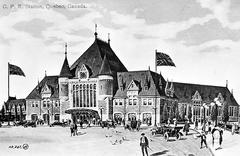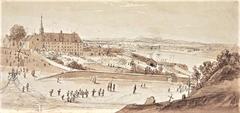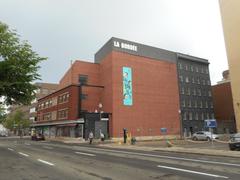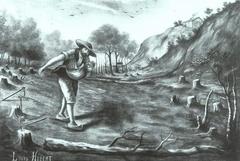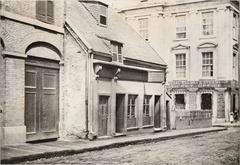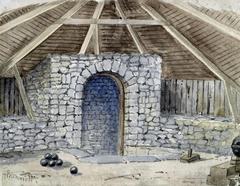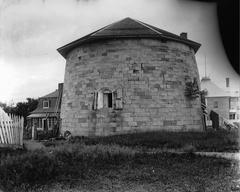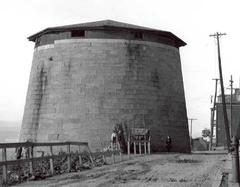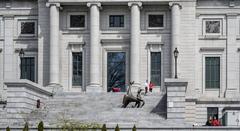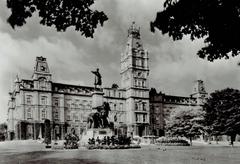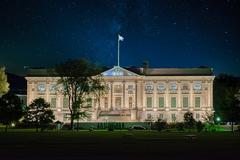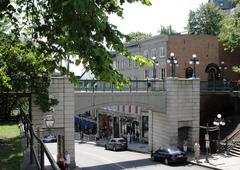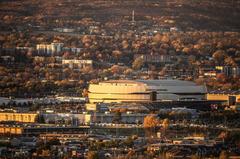
Equestrian Statue of Joan of Arc, Quebec City: Visiting Hours, Tickets, and Travel Guide
Date: 03/07/2025
Introduction
Nestled within the historic Plains of Abraham, the Equestrian Statue of Joan of Arc stands as a powerful symbol of courage, resilience, and the enduring French heritage that shapes Quebec City’s cultural identity. This iconic bronze monument, a meticulous replica crafted by American sculptor Anna Vaughn Hyatt Huntington and unveiled in 1938, commemorates Joan of Arc—the legendary French heroine and Catholic saint—and serves as a tribute to the values of patriotism and heroism shared by France, Canada, and the United States (Public Art Around the World; Wander Women Project).
Set within the beautifully designed Joan of Arc Garden, the statue’s location amplifies its historical resonance. The garden, conceived by landscape architect Louis Perron, harmoniously blends French and English landscaping traditions, creating a vibrant and tranquil haven that reflects Quebec’s dual cultural legacy (Plains of Abraham; Quebec City Official Tourism).
This comprehensive guide will help you discover the artistic, historical, and horticultural significance of the Equestrian Statue of Joan of Arc, with up-to-date information on visiting hours, accessibility, guided tours, and nearby attractions, ensuring an enriching experience in one of Quebec City’s most treasured sites (CCBN-NBC; Ville de Québec).
Contents
- Origins and Artistic Creation
- Commissioning and Artistic Vision
- The Gift to Quebec City
- Historical and Cultural Context
- Joan of Arc: Symbolism and Relevance
- The Donors and Their Motivation
- Joan of Arc Garden: Setting and Visiting Information
- Garden Creation and Horticultural Features
- Visiting Hours and Ticket Information
- Accessibility and Travel Tips
- Nearby Attractions
- Legacy and Replicas
- Frequently Asked Questions (FAQ)
- Plan Your Visit
- Sources and Further Reading
Origins and Artistic Creation
Commissioning and Artistic Vision
The Equestrian Statue of Joan of Arc in Quebec City is a bronze replica of Anna Vaughn Hyatt Huntington’s celebrated early 20th-century work. Huntington, renowned for her equestrian sculptures, was inspired by the 500th anniversary of Joan’s birth and the desire to strengthen Franco-American ties during a turbulent period in world history (Public Art Around the World).
To ensure authenticity, Huntington spent years studying French sculptors, attending medieval armor exhibitions, and observing live horses. The resulting statue depicts Joan in full armor, sword raised, capturing her determination and spiritual fervor in a dynamic and lifelike pose.
The Gift to Quebec City
Between 1921 and 1938, five full-size replicas of Huntington’s Joan of Arc were cast. The Quebec City statue, a personal gift from Anna and Archer Milton Huntington to the National Battlefields Commission, was unveiled on September 1, 1938, in a newly designed garden on the historically significant Plains of Abraham (Plains of Abraham; CCBN-NBC). The 28-ton stone base, sourced from the Notre Dame mountain range in the United States, underscores the cross-border nature of this gesture (Quebec City 101).
Historical and Cultural Context
Joan of Arc: Symbolism and Relevance
Joan of Arc (c. 1412–1431), “The Maid of Orléans,” is celebrated for her extraordinary role in the Hundred Years’ War, leading French forces to key victories before her martyrdom. Her legacy as a symbol of courage, faith, and resistance resonates deeply in Quebec, especially on the Plains of Abraham—a site marked by the pivotal 1759 battle between British and French forces (Equestrian Statue).
The statue’s presence on this battlefield, where French colonial rule ended in Canada, was initially controversial but ultimately recognized as a tribute to valor and a symbol of reconciliation (CCBN-NBC; Quebec City 101).
The Donors and Their Motivation
Anna Hyatt Huntington and Archer Milton Huntington were prominent American philanthropists who admired Quebec’s French heritage and sought to honor shared ideals of bravery and patriotism. Their donation of the statue to Quebec City was a gesture of international friendship, and its dedication—“A tribute to the patriotism and courage of the heroes of 1759-1760”—was intended to bridge historical divides (Plains of Abraham; CCBN-NBC).
Joan of Arc Garden: Setting and Visiting Information
Garden Creation and Horticultural Features
Designed in 1938 by landscape architect Louis Perron, the Joan of Arc Garden (Le Jardin Jeanne-d’Arc) provides a striking setting for the statue. The garden combines French classical symmetry with English-style mixed borders, featuring over 150 plant species—including annuals, perennials, and bulbs—arranged in geometric patterns and seasonal color displays (Plains of Abraham; BGCI; Quebec City Official Tourism).
The sunken design and mosaiculture (carpet bedding with living plants) create a microclimate ideal for horticultural diversity, while the central placement of the statue draws focus and reverence.
Visiting Hours and Ticket Information
- Open Daily: Typically 8:00 AM to 8:00 PM during peak season (May–October); reduced hours in winter.
- Admission: Free year-round.
- Location: Plains of Abraham, near Avenue Wilfrid-Laurier and Avenue George VI.
- Guided Tours: Available seasonally via Parks Canada and the National Battlefields Commission (Parks Canada).
Accessibility and Travel Tips
- Wheelchair Access: Paved and gently sloping paths, though some areas may be challenging after rain or thaw.
- Restrooms and Amenities: Available in the surrounding park.
- Transportation: Easily accessible by public transit; limited parking within the Plains of Abraham.
- Best Time to Visit: Late spring through early fall for peak blooms; winter visits offer a picturesque, snowy landscape.
Nearby Attractions
Make the most of your visit by exploring Battlefield Park Museum, Martello Towers, the Citadel of Quebec, and the historic Old Quebec district—all within walking distance.
Legacy and Replicas
Replicas Worldwide
Quebec City’s Joan of Arc statue is one of several full-size replicas of Huntington’s original, with others in New York City, Blois (France), Gloucester (Massachusetts), and San Francisco (CCBN-NBC). Each location underscores unique historical and cultural connections to Joan’s legacy.
Symbolism in Quebec’s Identity
The Equestrian Statue of Joan of Arc has become a beloved landmark, embodying resilience, cultural pride, and the spirit of reconciliation in Quebec. Its presence within the Plains of Abraham—once a site of conflict—now serves as an inspiration for reflection and remembrance (Plains of Abraham; Quebec City 101).
Frequently Asked Questions (FAQ)
Q: What are the visiting hours for the Joan of Arc Statue and Garden?
A: Generally 8:00 AM to 8:00 PM during peak season, with shorter hours in winter. Always check Parks Canada for current information.
Q: Is there an admission fee or are tickets required?
A: No, entry is free.
Q: Is the site accessible for visitors with mobility challenges?
A: Yes, the garden and statue area feature paved, wheelchair-accessible paths, though some gradients may become slippery when wet.
Q: Are guided tours available?
A: Yes, through Parks Canada and local operators.
Q: What is the best time to visit?
A: Late spring to early fall for peak floral displays; winter offers a peaceful snowy setting.
Q: What other attractions are nearby?
A: Battlefield Park Museum, Martello Towers, Citadel of Quebec, and Old Quebec.
Plan Your Visit
Experience the unique blend of art, history, and horticulture at the Joan of Arc Statue and Garden. Whether you seek historical insight, French heritage, or serene beauty, this landmark is a must-visit in Quebec City. For the latest updates, guided tour schedules, and events, visit the official Parks Canada Plains of Abraham page.
Alt text: Equestrian Statue of Joan of Arc in Quebec City’s Joan of Arc Garden, surrounded by blooming flowers.
Alt text: Mosaiculture carpet bedding design in the Joan of Arc Garden at the Plains of Abraham, Quebec City.
Visitor Recommendations
- Photography: The garden’s geometric flowerbeds and the statue’s striking silhouette make it a favorite spot for photos year-round.
- Etiquette: Remain on designated paths, avoid picking flowers, and keep pets leashed.
- Events: Look for annual events around Joan of Arc’s feast day (May 30) and seasonal garden tours.
- Accessibility: While the main paths are accessible, check conditions after rain or thaw.
Sources and Further Reading
- Public Art Around the World
- Plains of Abraham
- CCBN-NBC
- Quebec City 101
- Ville de Québec
- Wander Women Project
- Quebec City Official Tourism
- Parks Canada
Plan your visit today and experience one of Quebec City’s most inspiring monuments. Download the Audiala app for guided tours, follow local cultural channels for updates, and immerse yourself in the living history and beauty of the Joan of Arc Statue and Garden.




